Ejina, or Ejina Banner (banner is a county-level administrative region unique to Inner Mongolia Autonomous Region) covers an area of 114606 square kilometers and most of which is uninhabited desert. It is famous for the 260 km² natural reserve of populus euphratica, a kind of poplar tree. It is a hardy species that survived the long evolution of nature, with amazing ability of resisting drought, wind sand and salt alkali. Populus euphratica is the only tree suitable for growth in Central Asia and is known as the heroic tree as it "lives a thousand years after it is born, stands a thousand years after it dies, and remains imperishable for a thousand years after it falls". Ejina Populus Euphratica Forest is an important barrier to prevent the Badain Jaran Desert from spreading northward and a natural ecological treasure in Western China.
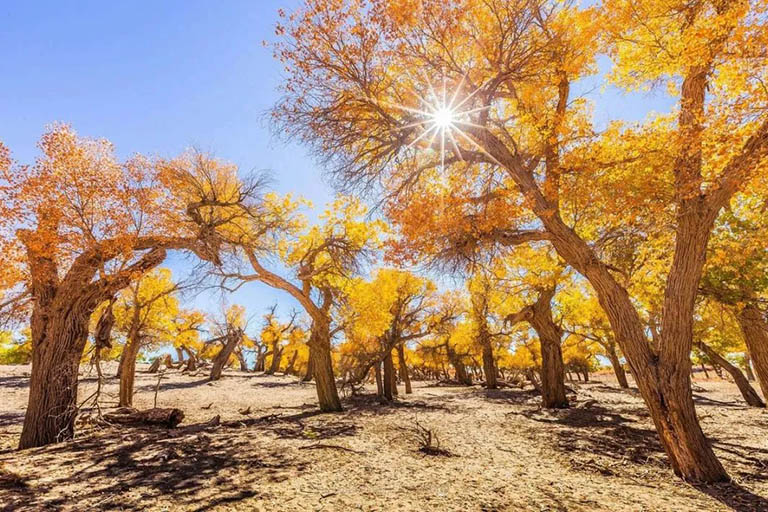 Ejina Populus Euphratica Forest
Ejina Populus Euphratica Forest
Ejina Populus Euphratica Forest consists of eight spots named from the First Bridge to Eighth Bridge. The First Bridge is the western entrance gate and tourist center, here you can also see some populus euphratica. The Third Bridge is a vast land of rose willows which is not a highlight of Ejina. The Fifth Bridge is more like a Mongolian restaurant where you can have a rest and the Sixth Bridge is not open to tourists. The Second Bridge, Fourth Bridge, Seventh Bridge, and Eighth Bridge are most visited.
The Second Bridge has always been the essence of Ejina Populus Euphratica Forest and it is a favored place for many photographers. Erdaoqiao is in a relatively primitive style, with wide waterways, scattered yurts and continuous sand dunes. Limpid clear autumn water, reflecting the golden trees, coupled with the blue sky, form a most attractive scenery. In fact, the populus euphratica forest of the First Bridge and the Second Bridge does not look as big and powerful as the Fourth Bridge, however, the water endows it with a special tender beauty. You can not only catch the golden reflection of the swaying trees, but also meet the beautiful sunrise with the most gentle morning sunshine if you come here early.
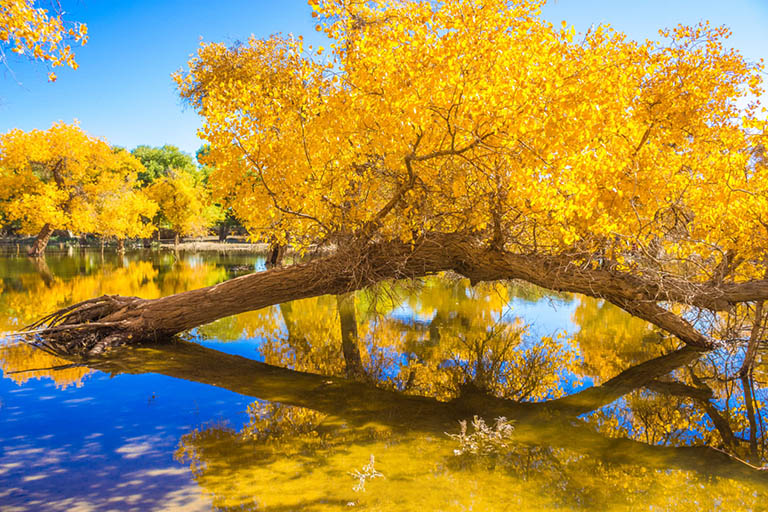 Second Bridge
Second Bridge
The Fourth Bridge is about 5 km away from the town, where a branch of Ejina River flows from south to north. Populus euphratica is distributed on both sides of the river, which is the most concentrated place of populus euphratica in Ejin Banner. People who have seen the movie Hero will be deeply impressed by such a picture: Feixue and Ruyue dressed in red, fighting and flying in the dancing golden leaves. This beautiful Scene was shot at extraordinary Sidaoqiao, so it is also called "Hero Forest". The lush trees in Sidaoqiao have thick trunks and strong branches in various shapes. In the Fourth Bridge, it is like you are appreciating a golden wave and feasting on brilliant autumn colors with dazzling brightness and intoxicating beauty.
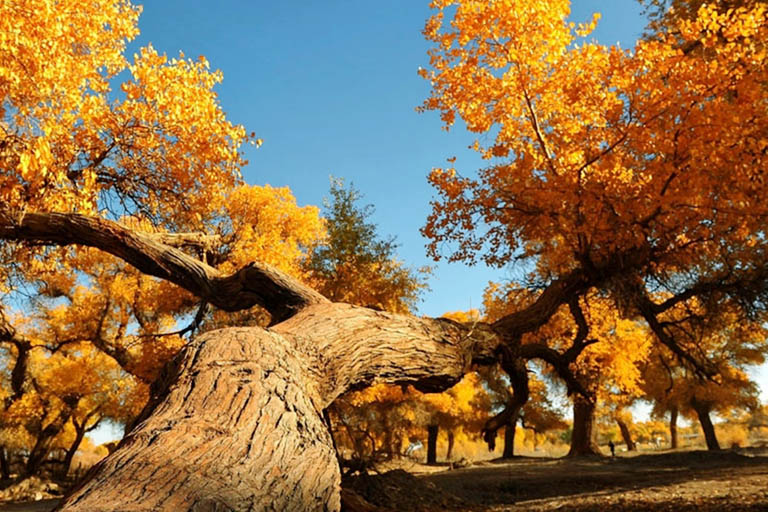 Fourth Bridge
Fourth Bridge
The Seventh Bridge is also called Dreamland Forest. The reflection of populus euphratica ripples into a picture between heaven and earth. Beams of light scatter on the water shedding through the trees, branches and leaves in red, orange, yellow and green, creating a beautiful autumn oil painting. The Seventh Bridge is covered with younger and smaller trees. They usher the approach of autumn with leaves turning yellow at the earliest. Therefore, people say that the Seventh Bridge is the beginning of awakening the life of Populus euphratica for thousands of years. Stepping on the wooden plank roads, it really feels like entering a dreamland.
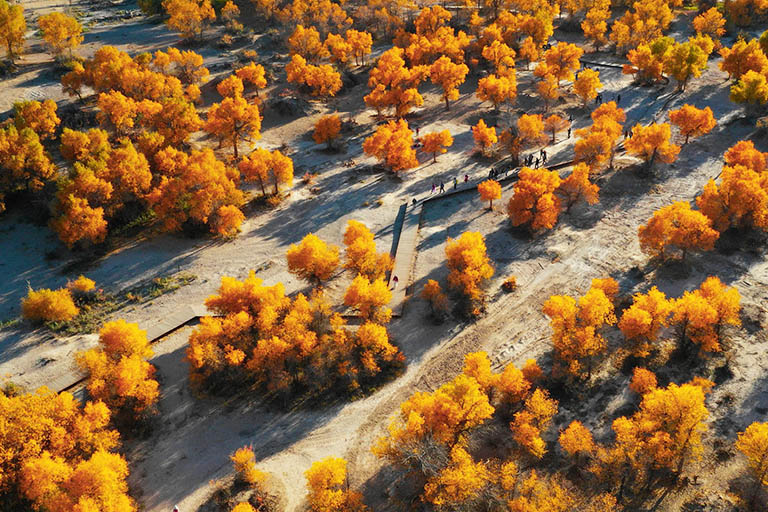 Seventh Bridge
Seventh Bridge
The Eighth Bridge is the combination of populus euphratica forest and desert landscape, offering a totally different scene from the other parts. It is in the northern part of Badain Jaran Desert, the third largest desert in China. Visitors can slide sand, ride camels and see sand sculptures of different styles. Actually, the desert shows different colors in different times. Sometimes it is earthy yellow, but at sunrise and sunset, the golden desert is particularly brilliant and it is very suitable to take some eye-catching pictures. Though not very high, climbing up to the dunes is a little challenging because of the strong wind. If you want to feel the ruggedness and magnificence of the desert, the Eighth Bridge is your solid choice.
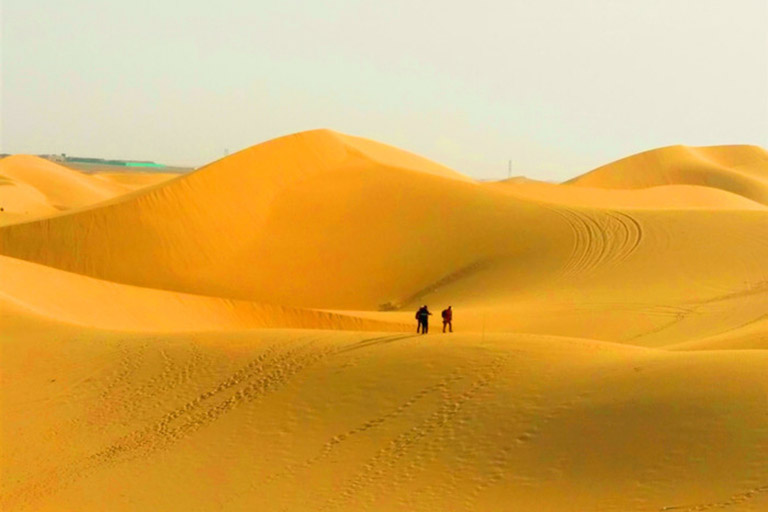 Eighth Bridge
Eighth Bridge
To get to the poplar forest, you need to get to Ejina Banner (Dalaihob Town) first, which is only 2.5 km from the scenic area. Ejina is located in western Inner Mongolia and you have several options to get there.
Option 1: By flight. Ejinaqi Taolai Airport operates stopover flight from Xi’an via Alax Left Banner with a total duration of about 4 hours. But the schedule is not stable. You can also fly to nearby cities with more flight schedules such as Jiuquan or Yinchuan first and then take a long-distance bus or charter a car to Ejina.
Option 2: By train. Ejina is only connected with Hohhot by train, which needs about 15 hours.
Option 3: By car. Most travelers choose to get to nearby cities first and then transfer to Ejina by car. Ejina is about 380 km (5.5h by car) from Jiuquan, 400 km (6h by car) from Jiayuguan, 500 km (7h by car) from Zhangye, 800 km (9h by car) from Yinchuan.
▶ Learn more about Ejina Transportation >
As Ejin Banner is not convenient in public transportation, it is highly recommended to find a reliable travel agency such as China Discovery to help with the transfer. Actually, if you book a private tour package with us, the sightseeing, dining, accommodation and transfer will all be covered. Our local tour guide and driver will escort you to Ejina Populus Euphratica Forest with speed and convenience, and take care of all the details. You just need to focus on sightseeing. Contact us now >
 Private Transfer with China Discovery
Private Transfer with China Discovery
Ejina Populus Euphratica Forest is so vast a scenic area stretching about 28 km with eight visiting areas mentioned above. Tourist bus is available in the First Bridge, Second Bridge, Fourth Bridge, Seventh Bridge, and Eighth Bridge with the fare included in the entrance ticket. It departs about every 15 minutes but in peak seasons, there may be a long queue and it is possible to wait for an hour to get a seat.
As for the visiting route, you can either visit from the First Bridge to the Eight Bridge or vise versa. The whole trip needs at least one day. If you only have a limited time of about half a day, you can choose some parts of them. The Second Bridge and Fourth Bridge are frequently chosen. If you are interested in desert landscape, you can also skip the previous one and have fun in the Eight Bridge.
The best time to visit Ejina Poplar Forest is from late September to middle October, about 20 days in total. In addition, it is recommended to avoid the Golden week from October 1-7 as there will be more visitors than usual, which makes the best-visiting time shorter and the unique autumn scene more precious.
The poplar trees in the Seventh Bridge are the earliest one for the leaves to turn yellow. So if you come to Ejina in late September, the Seventh Bridge is probably the only place where you can appreciate yellow leaves. If you go there in October, then most parts of the scenic area is a marvelous autumn scene and the leaves turn from yellow to golden and red gradually.
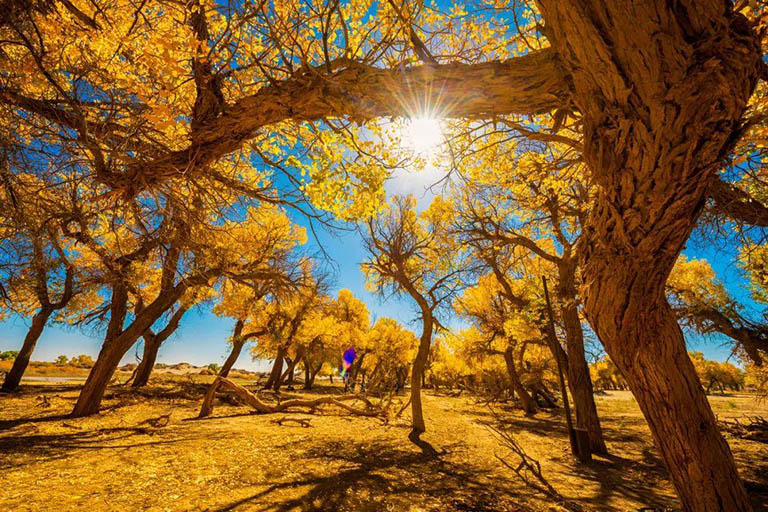 Ejina Populus Euphratica Forest in October
Ejina Populus Euphratica Forest in October
The accommodation condition in Ejina is limited both in number and facilities. There are some star-rated hotels in Dalaihob Town and many homestays run by the local people. Camping is not allowed in the scenic area. If you want to stay a night in Ejina in the peak season (September and October), it is very important to book your hotel as early as possible because almost all the tourists who want to go to Ejina will come in this period.
The most recommended accommodation area is Dalaihob Town (2.5 km from Ejina Populus Euphratica Forest) because there are many choices from the best hotels in Ejina such as Taihao International Hotel and Taolai Holiday Hotel to featured homestays. If you want to stay nearer to the scenic area, you can accommodate in the Container Hotel in the Eighth Bridge.
▶ Learn more about Where to Stay in Ejina >
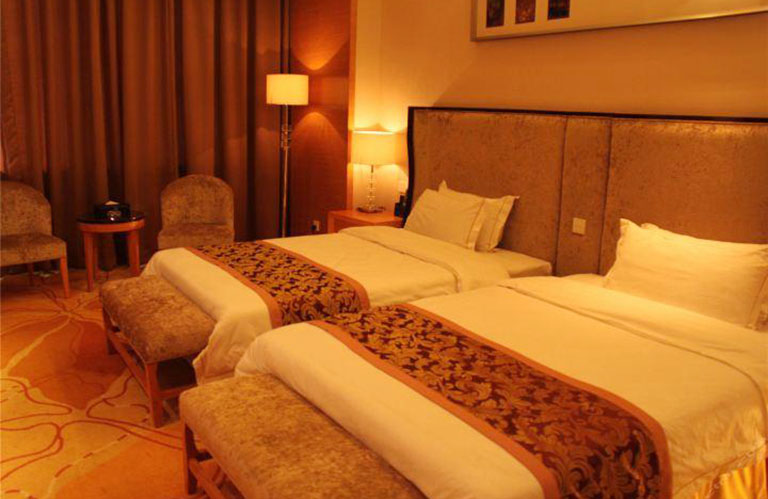 Taihao International Hotel in Dailaihob Town
Taihao International Hotel in Dailaihob Town
Weather & Temperature: The autumn of Ejina comes earlier than most parts of China and the average temperature is about 20℃, but at night, it becomes cold and sometimes drops to below 10℃. It rains little in September but is always windy.
Dressing for Photography: To form a strong color contrast with the golden forest and desert, red, white, and blue clothes are more likely to create beautiful pictures.
Most Suitable Time to Take Pictures: The best time to shoot poplar scenery is 9:00-10:00 and 15:00-16:00 when the sunlight is softer and the trees look more golden.
What to Pack: Apart from the suitable dress, it is highly recommended to bring sunglasses, facial cream, lip cream, etc. because it is dry in northwestern China and the sunlight is strong in the daytime.
Meal: This is a vast scenic area and you may spend a day there, so you are advised to bring some food and water for energy replenishing. Snack stalls are also available to sell simple food such as instant noodles but it is more expensive.
Luggage Storage: Free luggage storage service is provided in the scenic area. You can consult the staff in the tourist center.
Location: about 40 km, 40 minutes' drive from Dailaihob Town
As the name implies, Heicheng Ruoshui Huyang Scenic Area mainly consists of Heicheng Ruins, Ruoshui River with populus euphratica along the riverside, and Strange Forest.
Heicheng Ruins is the most complete and largest existing ancient city site on the Silk Road built in the 9th century. The vast yellow sand and five ancient pagodas are the main attractions. Seeing the remaining broken wall, people can not help wondering what happened in the past thousand years. Strange Forest is full of dead Populus euphratica trees, which is the best place to take a silhouette of Populus euphratica in the sunset. Every tree seems to tell you a story in the past and the joys and sorrows on the Silk Road. Ruoshui Populus Euphratica Forest is where you can appreciate the beautiful reflection of the trees on Ruoshui River.
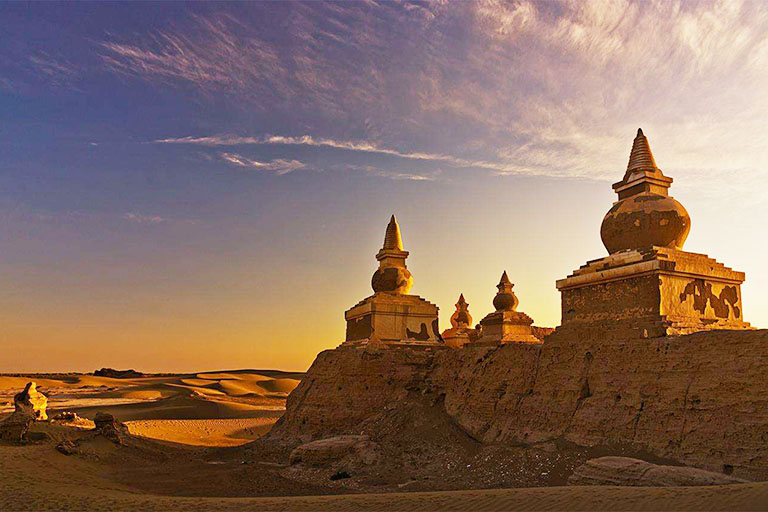 Heicheng Ruins
Heicheng Ruins
Location: 60 km, about 1 hour’s drive to the north of Dailaihob Town
Juyan Lake is one of the largest lakes in northwestern China in history. It is composed of East Juyan Lake (also known as Subonaoer) and West Juyan Lake (also known as Gashunnaoer) and other lakes. Now the Juyan Lake that tourists go to refers to East Juyan Lake and other lakes have dried up. Juyan Lake is narrow, long and curved, like a crescent moon. It is the beat place to appreciate sunrise in Ejin Banner with the fiery sun rising from the lake and birds flying in the sky. But if you visit there in peak season (September and October), you need to get up early to get a good position as there will be a lot of tourists.
On your way from Dalaihob to Juyan Lake, there is an 880-year-old sacred tree (ticket: CNY 10), which is 27 meters tall with a diameter of about 4 meters. 300 years ago, the Torgut people came to Ejina and found the tree. It stood tall and luxuriant while the other poplar trees are destroyed by fire caused by lightening. Therefore, it was believed to have magical power and was worshiped as the "Sacred Tree". Until today, when local herdsmen pass by, they will pay tribute to the tree and pray for a fortunate year and flourish livestock.
▶ Learn more about Ejina Attractions >
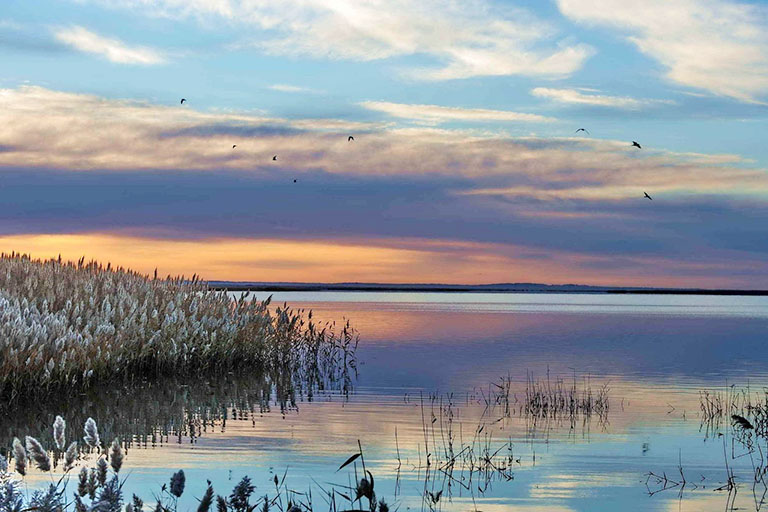 Juyan Lake
Juyan Lake
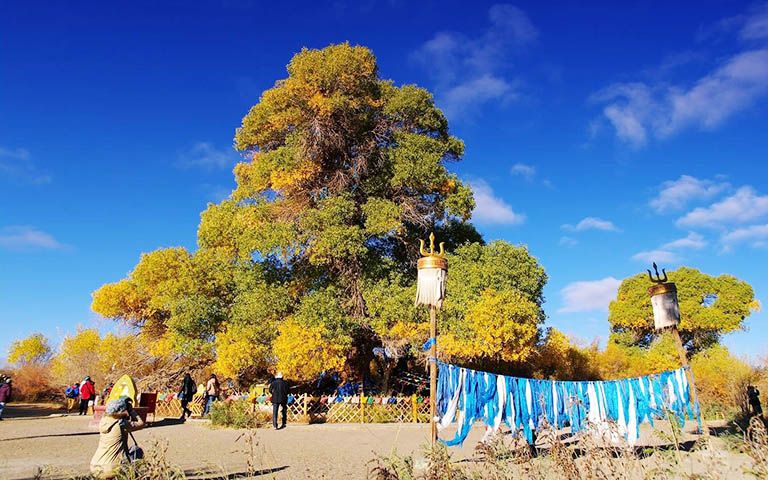 Sacred Tree
Sacred Tree
Popular Gateway Cities to Ejin Banner: Jiayuguan, Dunhuang, and Yinchuan
Best Time to Visit Ejin Banner: May to October, especially late September to mid-October
Where to Stay in Ejin Banner: Dalaihob Town
Generally speaking, a classic Ejin Banner tour takes about 4 days, with 2.5 days in total sightseeing. Ejina Populus Euphratica Forest is the premier highlight of Ejin Banner that attracts numerous photographers and natural lovers to admire its special beauty. It is recommended spending 1-2 days enjoying the high density of beautiful tree shapes and colors. Don’t miss Heicheng Ruoshui Huyang Scenic Area as well, where you will explore Heicheng Historic Site, and beautiful populus euphratica trees with refection in the water and peaceful river view. Beisides, visit Strange Forest to appreciate the oddly-shaped withered trees and a memorable sunset. On the last day, get up early and drive to Juyan Lake for the most brilliant sunrise in Ejina.
☛ 4 Days Ejina Populus Euphratica Forest Photography Tour
In addition to Populus Euphratica forests in Ejina, we strongly suggest you extend your trip to nearby destinations for more incredible wild nature views. Badain Jaran Desert with the world's tallest stationar dunes, colorful lake and mysterious echoing sand hills is a must-be-visited place. It is worth spending 2 days savoring its unique splendor.
☛ 6 Days Ejina Populus Euphratica & Badain Jaran Desert Sightseeing Tour
Besides, many travelers prefer a tour combining the golden Silk Road and Populus Euphratica together. You can spend about 5 days exploring the charm of Zhangye, Jiayuguan and Dunhuang along the Silk Road, and immersing yourself in an almost dizzying agglomeration of desert, grassland, raging river and colossal mountains in one go.
☛ 6 Days Hexi Corridor Discovery Tour(Zhangye/Jiayuguan/Dunhuang)
☛ 4 Days Jiayuguan Dunhuang Tour (Silk Road Short Break)
☛ 10 Days Classic Silk Road Tour (Xian/Dunhuang/Turpan/Kashgar)
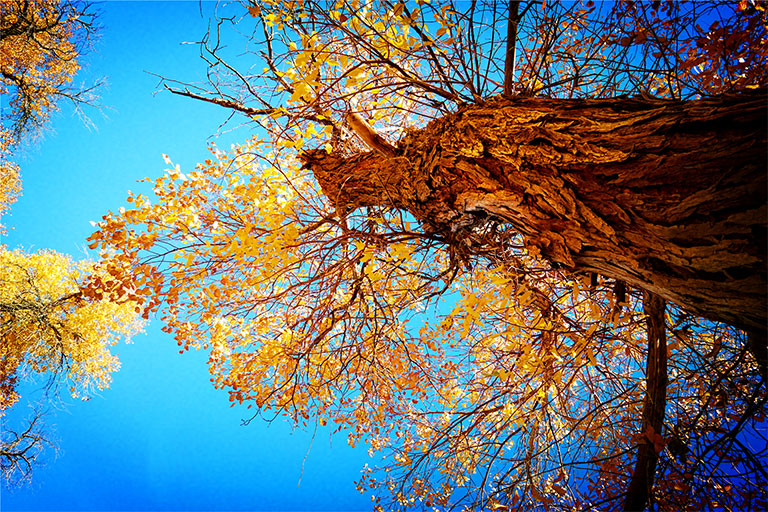 Ejina Populus Euphratica Forest
Ejina Populus Euphratica Forest
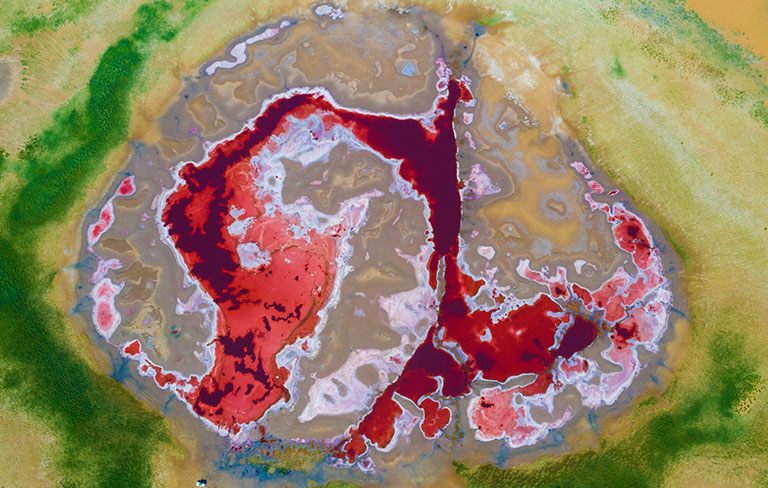 Beautiful Lake in Badain Jaran Desert
Beautiful Lake in Badain Jaran Desert
Top 3 Ejina tours chosen by most customers to explore Ejina in the best way. Check the detailed itinerary, or tailor your own trip now with us.
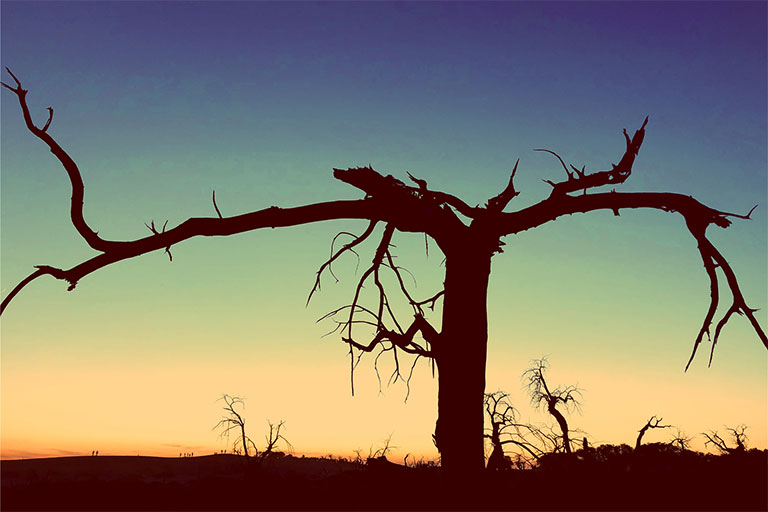
Ejina / Badain Jaran Desert
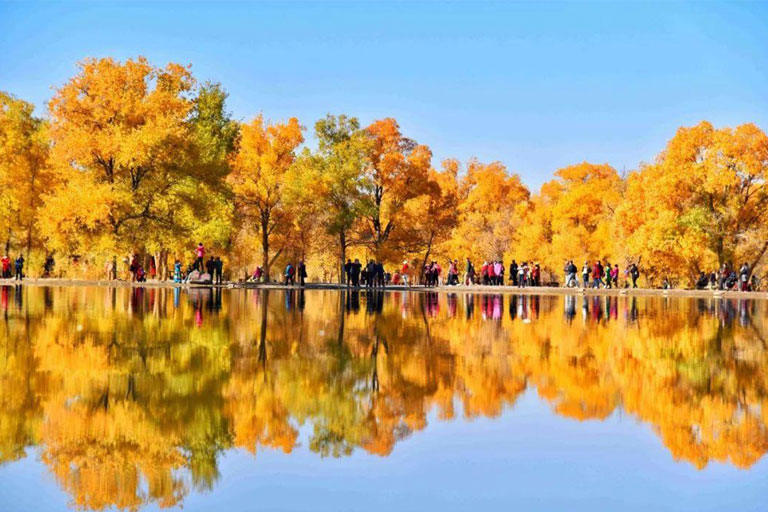
Zhangye - Jiuquan - Jiayuguan - Dunhuang
Start planning your tailor-made holiday to China by contacting one of our specialists. Once inquired, you’ll get a response within 0.5~23.5 hours.
Customize a Trip